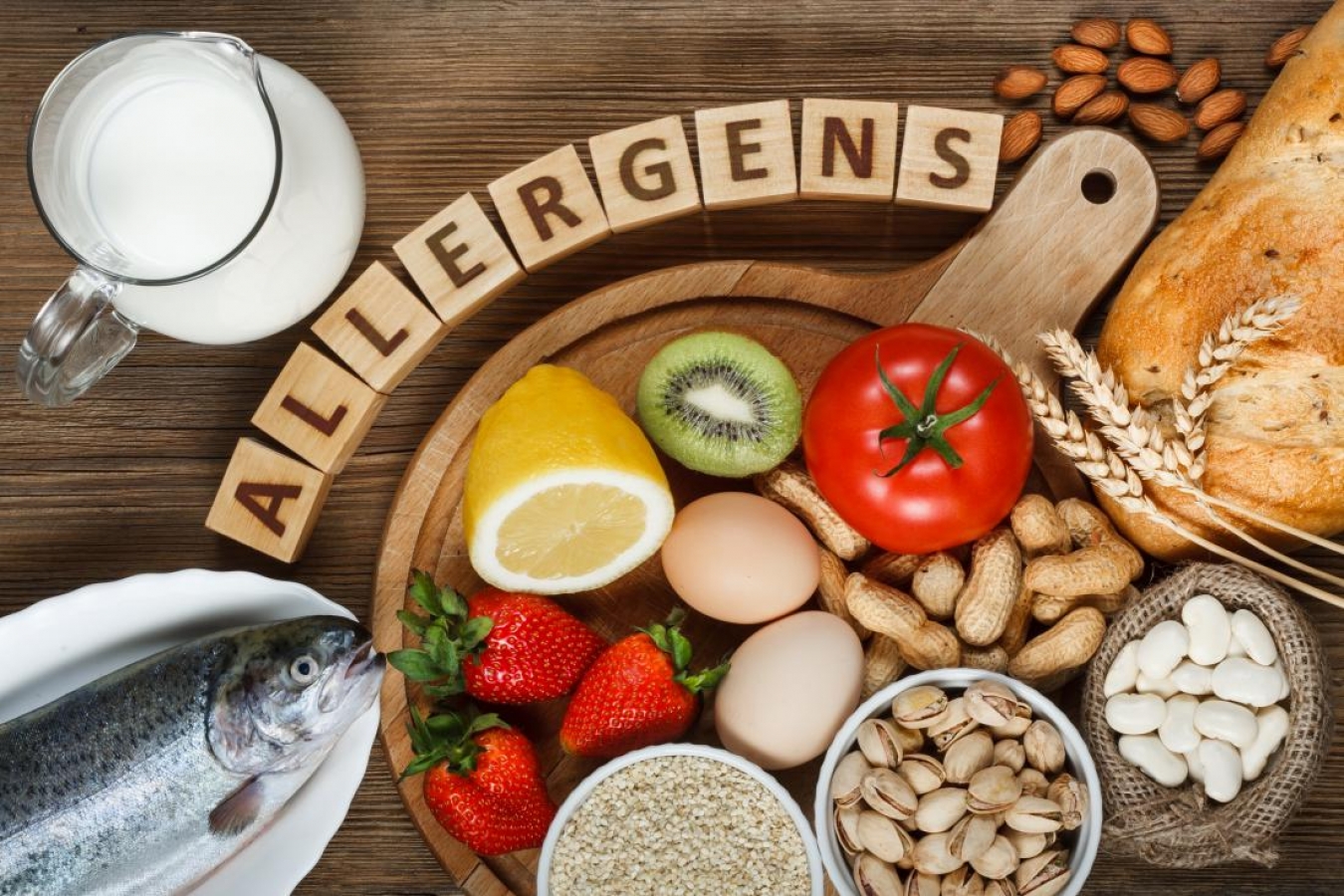


 4:50:28
4:50:28  2019-08-07
2019-08-07  939
939

People with a food allergy have an immune system that reacts to certain proteins found in food. Their immune system attacks these compounds as if it were a harmful pathogen, such as a bacterium or virus.
The National Institute of Allergy and Infectious Diseases estimates that about 5 percent of children and 4 percent of adults in America have a food allergy. This is a 20 percent increase in childhood food allergies in the last 20 years. Worldwide, food allergies affect 250 million to 550 million people in developed and developing countries.
In this article, we will cover the symptoms, causes, treatments, and triggers of food allergies.
Fast facts on food allergies
Here are some key points about food allergies. More detail and supporting information is in the main article.
Symptoms of food allergy
Symptoms can range from mild to severe and affect each individual differently. Not every person will experience all of the below, and each reaction may be slightly different, but commons signs and symptoms include:
Symptoms of anaphylaxis
Anaphylaxis means a severe allergic reaction. It usually occurs soon after exposure to the specific allergen, but can take a few hours.
Signs and symptoms usually come on quickly and worsen rapidly; they may include:
Common food allergy triggers
According to the National Health Service, United Kingdom, among children, the most common foods to trigger allergic reactions are peanuts, wheat, soya, milk, and eggs.
In adults, they are types of fish, peanuts, some shellfish, such as lobster, crab, and prawns, tree nuts, such as pistachios, Brazil nuts, almonds, walnuts, and peanuts.
The most common allergenic foods, which account for about 90 percent of all food allergies, commonly referred to as the "big eight," are:
European countries have additional top allergens that include sesame, celery, lupin (a legume), and mustard.
Diagnosing food allergies
The doctor will ask the patient about their reaction, including the symptoms, how long it takes for a reaction to occur, which foods cause it, whether the food is cooked or not, and where it was eaten.
The doctor will be interested in any other existing allergies, such as hay fever or asthma.
The patient will also need to tell the doctor about close relatives who might have allergies.
Skin prick test - diluted foods are placed on the patient's arm, and then the skin is pierced, introducing the food into the system. If there is any reaction, such as itching, swelling, or redness, it is likely there is some kind of allergy.
Skin prick testing can sometimes produce false-negative or false-positive results. Doctors usually order other tests to be sure.
Blood test - a patient's blood is drawn to check for IgE antibodies that are specific to certain food proteins.
Elimination diet - suspected foods are not eaten for 4-6 weeks, typically, to see whether symptoms clear up. They are then reintroduced to see whether symptoms return.
Elimination diets should be supervised by a doctor or dietitian. It is important not to exclude major groups of foods indefinitely. Elimination diets are often considered the gold standard for identifying problem foods since many diagnostic tests can produce false results.
Food diary - patients write down everything they eat and describe symptoms if they occur.
Physician- supervised blinded oral food challenge - this is more accurate. The patient is given several different foods. One of them has tiny amounts of the suspected allergen. The patient eats each one, and their reaction is observed closely.
Blinded means the patient does not know which food has the suspected allergen; this is important because some people react psychologically to some foods (this would not be classed an allergy).
This type of test should only be done by a doctor at a suitable medical facility.
Allergy vs. intolerance
Experts have found that many people who think they have a food allergy actually have a food intolerance, which is not the same. Food intolerances do not involve IgE antibodies, though other parts of the immune system may be involved.
Symptoms may be immediate or delayed and may be similar to those of food allergies. Unlike an allergy that is only in response to a protein, a food intolerance can occur due to proteins, chemicals, carbohydrates in foods, or from a lack of enzymes or compromised intestinal permeability.
The individual can typically eat small amounts of that particular food without being affected. The exception is someone with Celiac disease.
The following conditions or examples are often confused for food allergies:
Enzymes - the individual does not have an enzyme (or enough of it) to digest a food properly. For example, lactose intolerance, which causes diarrhea, gas, cramping, and bloating.
IBS (irritable bowel syndrome) - a long-term (chronic) condition in which the patient has diarrhea, constipation, and stomach pains. IBS sufferers are often intolerant to fermentable carbohydrates.
Food additive sensitivity - such as sulfites, which are used for preserving dried fruits or canned foods.
Psychological factors - some people may feel ill just thinking about a particular food. Nobody is quite sure why this happens.
Celiac disease - a long-term autoimmune digestive condition which is caused by the consumption of gluten. The patient may have diarrhea, stomach pains, and bloating, though many patients are asymptomatic. There is immune system involvement, but experts say it is a food intolerance, not an allergy.
Food allergy means even a small amount of food is likely to trigger the immune system, causing an allergic reaction. A food allergy may cause fainting, vertigo, dizziness, respiratory problems, swelling of various parts of the body, such as the throat, tongue, and face, and hives. The individual may also experience tingling in the mouth.
What causes food allergies?
In food allergies, the immune system treats a specific protein in a food as a harmful substance, a pathogen, something that may cause disease. It responds by producing antibodies to attack this protein.
When that same food is eaten next, the antibodies are ready and tell the immune system to react immediately. The immune system reacts by releasing histamine and other substances into the bloodstream. Histamine and these other chemicals cause the symptoms of food allergies.
Histamine causes blood vessels to dilate (expand) and the skin to become inflamed (swollen). It also affects the nerves, making the person feel itchy. The nose may produce more mucous, resulting in itching, burning, and a streaming nose.
Who is at risk?
Family history - scientists believe that some food allergies could be caused by genes people inherit from their parents. For instance, people who have a parent or sibling with a peanut allergy have a 7 times higher risk of having that allergy themselves compared with those with no family history.
Other allergies - those who have asthma or atopic dermatitis have a considerably higher risk of developing a food allergy than people with no other allergies.
Early years - research has also shown that babies born by cesarean section, who were given antibiotics at birth or within the first year of life, and those who had food introduced late, after 7 months, all had higher risks of allergies.
Gut bacteria - recent research shows that the gut bacteria in adults with nut and seasonal allergies is altered. Specifically, they have higher levels of bacteroidales and lower levels of Clostridiales strains. Scientists are trying to determine if influencing gut bacteria could help treat or prevent allergies.
Why do certain people have allergic reactions?
Food allergies appear to be on the rise. For instance, the CDC says "the prevalence of food allergies increased from 3.4 percent in 1997-1999 to 5.1 percent in 2009-2011." No one is sure why numbers are increasing; however, there are some theories:
Diet - some scientists suggest changes in eating habits in Western nations may be the cause, while others say it could be due to a lower consumption of animal fats and higher intake of vegetable fats.
Pesticides and genetically modified foods - some believe that high exposure to pesticide residues and consumption of genetically modified foods affects immune system function during development in utero and also as people age.
Antioxidants - most people eat less fresh fruit and vegetables than those of previous generations (foods high in antioxidants, which help protect against cell damage); perhaps a lower antioxidant intake during childhood undermines proper immune system development.
Vitamin D - food allergy prevalence is higher in countries further from the equator, where there is less sunlight, an important source of vitamin D. The suggestion is that low vitamin D intake may result in a higher food allergy risk.
Lack of early exposure - also known as the hygiene hypothesis. Children are being brought up in super-sterile environments, with much lower exposure to germs than their parents were. Developed countries with higher use of anti-bacterial soaps and products with less exposure to healthy bacteria in soils and the environment have significantly higher rates of food allergies.
Perhaps the immune system has not been exposed enough to successfully differentiate between good and harmful substances. This hypothesis does not only apply to food allergies but many other environmental allergies others as well.
However, all of the above are just theories, with no compelling evidence to support them.
Treatment options
Elimination diet - many patients will need to see a dietitian after being diagnosed with a food allergy. It is important if food needs to be eliminated from one's diet, that it is done in a way that does not undermine the individual's health.
For instance, if the allergy is just to peanuts, there will be no health consequences if the individual never eats peanuts again. However, an allergy to milk means finding other sources of calcium and protein.
Elimination may not simply mean not eating the particular food; it may also include never inhaling it, touching it, or eating foods with traces of it inside. Cutlery, crockery, cooking surfaces, and chopping boards must be free of the allergen.
Patients will need to read food and drink labels carefully. Even some soaps, pet foods, glues, and adhesives may have traces of a food allergen.
When eating out, being vigilant can be particularly difficult.
Medication for emergencies
Antihistamines - these will come in the form of gels, liquids, or tablets. They are usually effective for patients with mild or moderate allergies. Histamines are chemicals which cause most allergy symptoms, and antihistamines block their effects.
Epinephrine (adrenaline) - this is used by individuals who have food allergies that may result in anaphylaxis. Epinephrine keeps blood pressure up by constricting blood vessels, as well as easing the airways.
People who have had severe allergic reactions should carry an epinephrine auto-injector with them, for instance, the EpiPen, EpiPen Jr., Twinject, or Anapen.
Reality Of Islam |
|

The process

Astronomers

Cosmologist

Scientists
 9:3:43
9:3:43
 2018-11-05
2018-11-05
10 benefits of Marriage in Islam
 7:5:22
7:5:22
 2019-04-08
2019-04-08
benefits of reciting surat yunus, hud &
 9:45:7
9:45:7
 2018-12-24
2018-12-24
advantages & disadvantages of divorce
 11:35:12
11:35:12
 2018-06-10
2018-06-10
 6:0:51
6:0:51
 2018-10-16
2018-10-16
 8:21:9
8:21:9
 2018-06-21
2018-06-21
al-hussain (peace be upon him)
 10:18:1
10:18:1
 2022-09-21
2022-09-21
 1:16:44
1:16:44
 2018-05-14
2018-05-14
 8:15:37
8:15:37
 2023-02-16
2023-02-16
 9:42:16
9:42:16
 2022-10-19
2022-10-19
bahlool & the throne of haroun rashid
 8:20:35
8:20:35
 2018-06-21
2018-06-21
 2:11:12
2:11:12
 2022-10-15
2022-10-15
 5:41:46
5:41:46
 2023-03-18
2023-03-18
| LATEST |